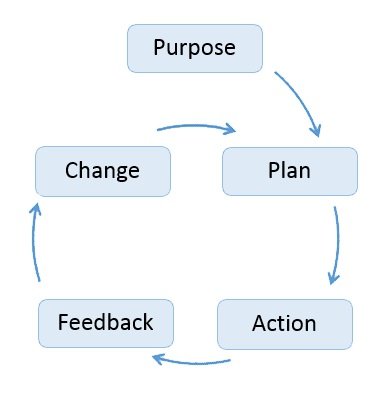How can I Get People to Change?
How can you get people to change?
It is clear that you need to improve the current system you are using at work; and that means that you need people to change what they are doing and adopt the new system.
But the problem is that most people don't like change. So they don't want to adopt your new system. They want to keep the old system; the system that they are used to; the one they know how to operate; the system they feel comfortable with.
They don't like the new system, they are not used to it, they don't know how to work it, and they don't feel very comfortable when they are forced to use the new system.
So they fight the introduction of the new system; even though the new system will be better, in the long run.
So we can sum up the problem like this:
You need people to change: but they don't want to change.
And we can sum up the question to be answered like this:
How can I get people to change?
Here are the steps.
You need to know three fundamental principles about human beings, and apply these principles to the issue of change management.
- Most people are motivated by their own self-interest. (They are not motivated by YOUR self-interest).
- Most people think most about the short range consequences of their actions. They don't think much about the long range consequences of their actions.
- Most people don't like things that are too complex. They like things to be simple.
If you agree with the above statements, then we can derive the following three methods about how to get people to change.
How to get people to change. Method 1
Since most people are motivated by their own self-interest and not motivated by your self-interest, then it is important to:
Sell the idea of change in terms of the benefits it will bring for the person making the change, not for the benefit of everyone else.
If you say, "This change will make life easier for our customers and will increase the profits for the shareholders, but it will make your life more difficult." then don't expect much cooperation to implement the change.
Remember this phrase: People are selfish!
(Meaning: "self-interested").

You need to recognise this fact about your employees.
They do not work for you or for your organisation.
No.
Instead, they work first for themselves and their family. They only use your organisation as a means to an end. They are not working in order to help you. They are at work for the benefit of themselves and their family, first.
So you need to present the change in terms that will appeal to the self-interest of the changer.
- Do not appeal to his sense of duty.
- Do not ask him to take one for the team.
Do not ask him to sacrifice his own self-interest for the benefit of the organisation as a whole, or the customers, or the shareholders.
See the change from the changers perspective and make every argument for the change an expression of how this will bring benefits for the changers. Long range benefits.
How to get people to change. Rule 2
Emphasis the long range consequences. De-emphasis the short range consequences.
You need to recognise this fact about people:
Most people think more about the short range consequences of their current actions.
They don't think much about the long range consequences of their actions.
They think about the short range consequences of eating mass quantities of ice cream. They don't think much about the long range consequences of eating mass quantities of ice cream.
They think about the short range consequences of driving at 90 miles per hour. They don't think much about the long range consequences of driving at 90 miles per hour.
In order to make your change programme make sense you must acknowledge that, short term, this change programme will be a pain to the people making the change.
But LONG TERM, the people making the change will see benefits for themselves.
Your task is to focus the attention on the long term consequences of the change.
You will have to acknowledge the short term pain. But your goal is to talk about the long term benefits. Don't get caught up for too long on the short term consequences.
Focus on the long term.
How to get people to change. Rule 3
Make changes small and simple, NOT large and complex.
Remember that most people don't like things that are complex. They like things to be simple.
All changes can be put into two classes of change.
- Revolutionary change
- Evolutionary change
Revolutionary change seems to be catastrophic, big bang, painful and costly.
Evolutionary change is smaller, gradual, progressive and not painful.
It is important to present the change program as an evolution, not a revolution.
You need to do all you can to make the big change, look more like a series of small changes.
Make the big bang theory and evolutionary theory.
People don't like big bang revolutions.
It makes them fearful.
Most people would prefer a gradual evolutionary approach.
So break the big change up into a million small evolutionary changes and start implementing the change at "baby step one".
They can accept taking a baby step. They don't want to make a giant leap.
Giant leaps are for Hero's and giants.
Don't ask people to make giant leaps.
Ask them to evolve.
Make a big change feel like a series of small changes.
People don't like revolution. They prefer evolution.
Summary. How can I get people to change?
You need people to change: but they don't want to change.
How can you get people to change?
Here are the steps.
Sell the idea of change in terms of the benefits it will bring for the person making the change, not for the benefit of everyone else. You need to present the change in terms that will appeal to the self-interest of the changers.
- Do not appeal to his sense of duty.
- Do not ask him to "take one for the team".
You will have to acknowledge the short term pain. But your goal is to talk about the long term benefits. Don't get caught up for too long on the short term consequences.
Focus on the long term.
Most people would prefer a gradual evolutionary approach to change.
So break the big change up into a million small evolutionary changes and start implementing the change at "baby step one".
Make change programme seem like:
- A progressive evolution,
- NOT an aggressive revolution.
Thank you.
Definition: Change management
Change management is the business process that guides people from the old way to a better new way. It works by showing staff the long-term rewards, linking the change to each person’s self-interest, and turning one large leap into a series of easy steps. When these parts are missing, real change stalls.
Show CG4D Definition
- plans and controls moves from an old way of working to a new one
- explains the long-term gains and admits the short-term pain
- shows each person how the change serves their own aims
- splits a big change into many clear, easy steps
Article Summary
To get employees to accept change, show each person how the new way helps them, highlight the long-term rewards over short-term hassle, and present one small step at a time; when people see personal gain, future value and an easy path, they choose to move with you.
Frequently Asked Questions
Here are some questions that frequently get asked about this topic during our training sessions.
Why do employees resist change at work?
How do I link change to staff self interest?
How can I highlight long-term benefits clearly?
Should I mention short-term pain during a change plan?
How do small steps ease resistance to change?
What is evolutionary change versus revolutionary change?
How can I motivate staff without using duty language?
Thought of something that's not been answered?
Did You Know: Key Statistics
Prosci’s 2024 Change Management study found that projects with very good change support meet or beat their goals 93% of the time, while projects with poor change support do so only 15% of the time. A 2024 Gartner survey of HR leaders reports that 73% of staff felt worn out by the amount of change last year, and only 38% trust their organisation to handle change well.Blogs by Email
Do you want to receive an email whenever we post a new blog? The blogs contain article 5-10 minutes long - ideal for reading during your coffee break!
Further Reading in Change Management
-
Change Should be an Evolution, Not a Revolution
Learn how evolutionary change over small, steady steps lifts success, eases staff fatigue and doubles results, making change management safer and effective.
Read Article > -
Technology Accelerates Change
Technology change is reshaping work and life. Learn three rules to embrace rapid shifts, learn from young talent and keep core values with change management.
Read Article > -
Why Won't People Accept Change?
Learn why resistance to change blocks progress and follow clear, low-risk steps that help people accept change, build good habits and reach long goals.
Read Article > -
Why do people resist change?
People resist change because habits feel safe and uncertainty risky. Learn why we cling to familiar ways and gain steps to build new habits and embrace change.
Read Article > -
Managing Negative Attitudes To Change
Master change management by guiding staff talk. Shift chat from fear and nostalgia to facts and future plans, cut resistance and speed your team's progress.
Read Article >
Looking for Change Management Training?
If you're looking to develop your Change Management Skills, you may find this Change Management Training Course beneficial:
Open Training Course Pricing and Availability
In-House Course Available Call us on 020 3856 3037 to discuss your requirements or







